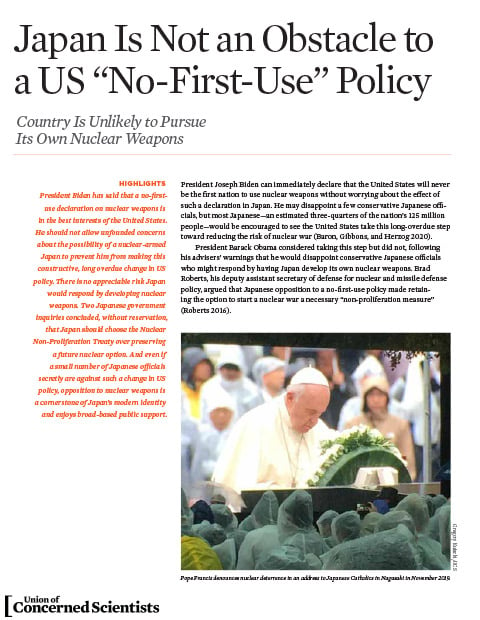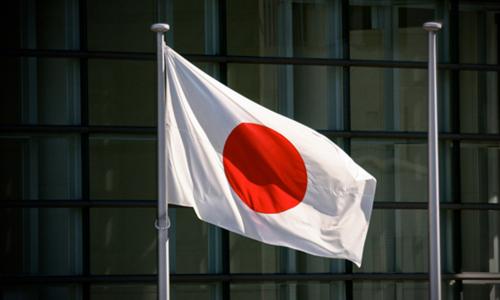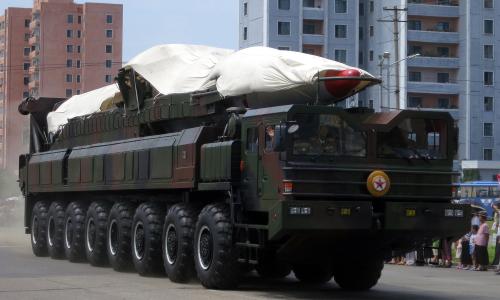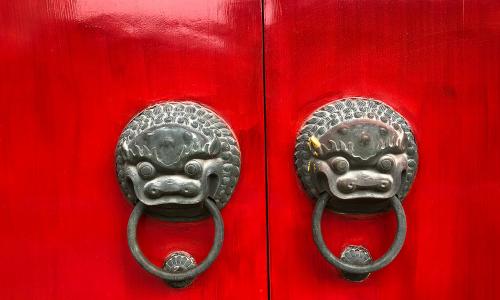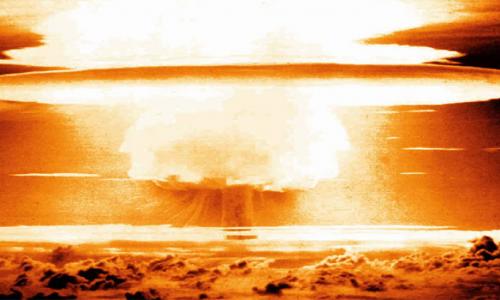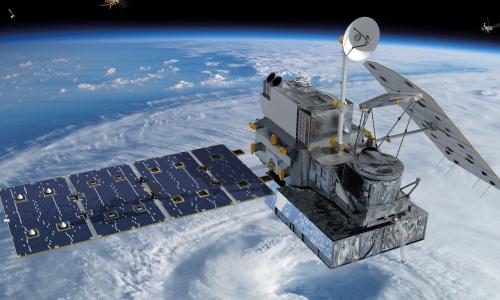President Biden has said that a no-first-use declaration on nuclear weapons is in the best interests of the United States.
He should not allow unfounded concerns about the possibility of a nuclear-armed Japan to prevent him from making this constructive, long overdue change in US policy. There is no appreciable risk Japan would respond by developing nuclear weapons. Two Japanese government inquiries concluded, without reservation, that Japan should choose the Nuclear Non-Proliferation Treaty over preserving a future nuclear option. And even if a small number of Japanese officials secretly are against such a change in US policy, opposition to nuclear weapons is a cornerstone of Japan’s modern identity and enjoys broad-based public support.
Japan Is Not an Obstacle to US “No-First-Use” Policy
This is a condensed, online version of the report. Access to all figures and full report are available through download of the PDF.
President Joseph Biden can immediately declare that the United States will never be the first nation to use nuclear weapons without worrying about the effect of such a declaration in Japan. He may disappoint a few conservative Japanese officials, but most Japanese—an estimated three-quarters of the nation’s 125 million people—would be encouraged to see the United States take this long overdue step toward reducing the risk of nuclear war (Baron, Gibbons, and Herzog 2020).
President Barack Obama considered taking this step but did not, following his advisers’ warnings that he would disappoint conservative Japanese officials who might respond by having Japan develop its own nuclear weapons. Brad Roberts, his deputy assistant secretary of defense for nuclear and missile defense policy, argued that Japanese opposition to a no-first-use policy made retaining the option to start a nuclear war a necessary “non-proliferation measure” (Roberts 2016).
Those advisors are wrong. Japan is extremely unlikely to choose to develop nuclear weapons, especially in response to a policy change that would strengthen international anti-nuclear norms. As three clear indicators show, Japan does not pose a proliferation risk, and the United States can declare a no-first-use policy without undermining Japan’s commitment to remaining a non-nuclear-weapons state under the Nuclear Non-Proliferation Treaty (NPT).
-
Prior Japanese assessments of their country’s options concluded that the benefits of possessing nuclear weapons were ephemeral and not worth the political, diplomatic, and economic costs. The calculations underlying those conclusions have not changed.
-
An overwhelming majority of Japanese want to abolish nuclear weapons entirely.
-
Even the conservative Japanese officials who lobby the United States to retain first-use options do not claim that Japan would develop nuclear weapons in response to a US no-first-use declaration. Neither do they have the political agency to make it happen. An unrepresentative minority, they must operate in secret to avoid public dissent. Moreover, they have not identified any scenario in which the first use of nuclear weapons by the United States would be necessary or desirable, nor can they explain how no-first-use compromises Japan’s security. The threat of US nuclear retaliation would continue to deter nuclear attacks against Japan.
As a senator, Biden expressed support for a no-first-use policy, and many members of Congress support it today. Unfounded concerns about the possibility of a nuclear-armed Japan should not prevent US decisionmakers from taking this long overdue step toward reducing the risk of nuclear war.
The Origins of US Fears of a Nuclear-Armed Japan
Many members of Congress, as well as a number of other US government officials and nuclear policy experts, believe Japan is a proliferation risk.1 Officials in Washington have discussed the problem for decades. State Department cables from the 1960s and 1970s mention concerns about a Japanese “irrationality” that both “glorified war” and could inspire a quick decision to develop nuclear weapons (FRUS 1968; FRUS 1965). One US official argued that a nuclear Japan was possible, despite that country’s post-WWII pacifism: “the Japanese are an emotional people,” he wrote. He drove the point home with a disturbingly racist caricature: “The pendulum can swing wildly. The picture of a Japanese officer cutting off the head of a prisoner and then weeping fifteen minutes later at the sight of cherry blossoms is perfectly credible” (FRUS 1971).
In the late 1990s and early 2000s, a rush of US-authored essays raised the possibility Japan would go nuclear in response to North Korean missile tests, Indian and Pakistani nuclear tests, or Chinese nuclear modernization.2 One of the more influential, co-authored by a US official who continues to play a leading role in shaping US Asia policy, opens with an interpretation of a Japanese comic book or “manga.” The manga reference intentionally revived the caricature of an unpredictable Japanese culture whose inscrutable lines between pacifism and militarism could shift quickly and result in a nuclear-armed Japan (Campbell and Sunohara 2004).
The evidence presented in those essays was thin: a few provocative statements from a handful of conservative Japanese essayists and politicians. Yet the impact on the US discussion was considerable. The specter of a nuclear-armed Japan became so pervasive it was repeated in an episode of the popular television drama The West Wing (West Wing 2003).
Today, the perception in US government circles that Japan could leave the NPT and develop nuclear weapons if the United States adopts a no-first-use policy is based entirely on the reports of US officials who claim their Japanese counterparts convey this impression in confidential conversations (Roberts 2016). However, the number of Japanese officials who would have the opportunity to communicate their views in this manner is extremely small, perhaps no more than 15 to 20 individuals at any given period in US-Japan relations.
An additional reason so many US experts and officials believe reports that such a small group could rapidly transform Japan into a nuclear weapons state is their country’s ability to reprocess spent nuclear fuel and store the extracted plutonium (see Box 1). Occasionally, a few Japanese officials have suggested that the latent potential to make nuclear weapons with civilian plutonium has some deterrent value, but, like Tanaka Nobuo, a former senior nuclear policy official in Japan’s Ministry of Economy, Trade, and Industry, they also admit that Japan “has no intention whatsoever of acquiring nuclear weapons” (von Hippel, Takubo, and Kang 2019). More important, in 1970, when the Japanese government did seriously consider developing nuclear weapons, it made no mention of the availability of civilian plutonium as a contributing factor in its deliberations. When reviewing its nuclear options in 1995, Japanese experts noted that the country could not use civilian plutonium to develop nuclear weapons: this fissile material is under International Atomic Energy Agency safeguards, a requirement imposed by both the NPT and Japan’s nuclear technology agreement with the United States.
Japan’s Assessments of the Nuclear Option
The Japanese government has conducted two inquiries into whether Japan should develop nuclear weapons. Both inquiries concluded, without reservation, that Japan should choose the NPT over preserving a future nuclear option.
THE FIRST INQUIRY: Deciding to Join the NPT
The first inquiry was completed in 1970 during a period when the government was considering signing the NPT. Conducted in secret, the inquiry has never been released to the public,4 which in 1967 had pressured elected officials into adopting what have come to be called Japan’s Three Non-Nuclear Principles. The principles forbid Japan from possessing nuclear weapons, producing them, or permitting their introduction into Japanese territory.
The inquiry assessed Japan’s technical capacity to develop nuclear weapons. Further, it analyzed decisions of other nuclear weapons states, especially France and China, and examined the long-term threat to Japan from China’s program. It also considered the potential reactions of other nations, especially the Soviet Union, the United States, and neighboring Asian countries, to a Japanese decision to become a nuclear weapons state. Finally, it assessed how a decision to develop nuclear weapons might affect Japan’s international reputation and domestic politics (Study Group on Democracy 1968; Study Group on Democracy 1970).
The inquiry concluded that Japan could overcome most of the technical obstacles to developing nuclear weapons except, perhaps, the difficulty of conducting underground tests. However, it was primarily the nontechnical considerations that weighed against a decision to move forward. The inquiry noted that both France and China had developed nuclear weapons because they lacked confidence in the nuclear umbrellas of the United States and the Soviet Union. While expressing concern about China’s decision to develop nuclear weapons, which created a potential for nuclear blackmail against Japan, the inquiry concluded that China’s program was defensive, not aggressive—a product of and a remedy for Chinese fears of US and Soviet nuclear intimidation. For this reason, China would not be inclined to blackmail Japan, especially given the prospect of US retaliation. Moreover, a Japanese decision to acquire nuclear weapons would make both the Soviet Union and the United States wary of the intentions of a more independent and remilitarized Japan.
The inquiry also noted that while developing nuclear weapons might enhance Japanese national prestige, the effect would be short-lived. International and domestic political opposition to the decision would be destabilizing.
Having weighed all these factors carefully, the inquiry concluded that a nuclear weapons program would not strengthen Japan’s security (Study Group on Democracy 1970).
THE SECOND INQUIRY: Permanently Extending Japan’s Commitment to the NPT
Completed in 1995, the second inquiry was also conducted in secret and kept confidential for fear of public reprisal. Twenty-five years after declaring Japan a non-nuclear-weapons state under the NPT, the Japanese government once again considered the nuclear option and its commitment to the treaty.
The NPT text states that the signatories would consider extending the treaty for a fixed period or possibly indefinitely. Japanese agreement to its extension would imply a commitment to permanently abandoning the nuclear option. The NPT allows states to withdraw from the treaty but only if “extraordinary events” threaten their “supreme interests.” Having to make that case before the international community would require compelling proof, acknowledged by the other NPT signatories, of an extraordinary threat to Japan. Withdrawing without sufficient justification could subject Japan to the same severe international economic and political sanctions imposed on North Korea.
This inquiry concluded that the geopolitical consequences of developing nuclear weapons would be unacceptable (Japan Defense Agency 1995). Withdrawal from the NPT would undermine and potentially lead to the collapse of a highly valued, increasingly successful global effort to curb nuclear proliferation, an effort deemed essential for Japanese and international security. It would also damage the Japan-US alliance. The United States and other countries would begin to worry about new and complex security challenges posed by a more independent, nuclear-armed Japan. A decision to arm Japan with nuclear weapons would also undermine the credibility of the US nuclear umbrella for other non-nuclear nations and upset the global balance of power.
The inquiry connected these geopolitical consequences to anticipated economic costs. A Japanese choice for an independent national defense over collective security would have serious economic repercussions not just for Japan but for the region and the rest of the world. A nuclear Japan would destabilize the Asian economy, which by 1995 was becoming a major engine of global economic growth. Widespread international condemnation could bring economic reprisals that would threaten Japan’s survival as a trading nation.
The inquiry went further, identifying three domestic factors that called into question whether developing nuclear weapons would make Japan more secure. First, Japan is especially vulnerable to nuclear attacks because its population is concentrated in a few megacities on a comparatively small, mountainous, and geologically volatile land mass. In the opinion of the analysts conducting the inquiry, this extreme vulnerability made a “mutual assured destruction” strategy against nuclear weapons states like Russia, China, and the United States untenable.5 Second, constructing and maintaining the infrastructure for a nuclear weapons program and an independent national defense would be too costly, both politically and economically. Third, developing nuclear weapons would undermine domestic security. Japan’s deep-rooted national sentiment against nuclear weapons would precipitate polarizing confrontations that would destabilize domestic politics and weaken the government.
The inquiry looked at several contingencies that US experts and officials often cite today as potential triggers of Japanese development of nuclear weapons. One was the possible development of nuclear weapons by North Korea. Yet the inquiry described that program sympathetically as “a dagger stuck to China’s throat.” The metaphor was intended to emphasize that North Korea’s program also threatens China, which had no grounds to stop it because it was motivated by the same “self-defense” rationale China had used to justify its own decision to develop nuclear weapons.
The Japanese inquiry also took a somewhat cynical view of international efforts to punish North Korea. It quoted a French military critic who characterized North Korea as an easy-to-punish “scapegoat” when compared with Israel, India, and Pakistan, which received more favorable treatment when they rejected the NPT. The quote highlighted the political importance of the North Korea problem to the United States, but in the end the inquiry concluded that it was “hard to see the need” for Japan to confront a nuclear North Korea “by going nuclear.”
The inquiry imagined a more “nationalist” China focused on unification and the possibility of a US-China war over Taiwan. It considered the possibility that China would abandon its policy of nuclear no-first-use, establish effective control over the Senkaku Islands, and unilaterally develop the continental shelf in disputed waters. Yet the inquiry concluded that a nuclear-armed Japan would not be a viable solution to the problems presented by this situation.
Finally, the inquiry considered a worst-case scenario in which the NPT collapsed, various other countries started developing nuclear weapons, and the US-Japan alliance broke down. “Even in such a case,” the inquiry concluded, “it is questionable whether there is any value for a trading nation that depends on the stability of international society to try to secure its survival and protect its interests with its own nuclear weapons.”
Having carefully considered these contingencies and taken many international and domestic factors into account, the 1995 inquiry concluded, “It is not favorable for Japan to take the nuclear option.”
The two in-depth inquiries into Japan’s nuclear options reveal that Japan would not choose the nuclear option even when considering changes to Japan’s security situation far more serious than comparatively small changes in US nuclear weapons policy. If the Japanese government would not develop nuclear weapons in response to a simultaneous collapse of the NPT and the US-Japan alliance, it is difficult to believe the reports of US officials who believe that Japan could go nuclear in response to a US expression of intent not to use nuclear weapons first.
Japan’s Secretive Pro-Nuclear Minority
It is difficult to assess how many Japanese officials want the United States to retain the option to use nuclear weapons first or why. Japanese officials who are reported to favor preserving first-use options will not admit it. Former Prime Minster Abe Shinzo, for example, has denied telling US officials he opposes a US no-first-use declaration (Abe 2018).
The US-Japan nuclear alliance has always relied on secrecy to protect Japanese officials from public scrutiny. For decades, they have been caught between US policies that call for the use of nuclear weapons to defend Japan and the Japanese public’s vehemently anti-nuclear sentiments. This challenge intensified when Japan adopted what are known as the Three Non-Nuclear Principles: Japan will not possess nuclear weapons, manufacture them, or allow their introduction into Japanese territory. Prime Minister Satō Eisaku introduced the principles in a 1967 speech to the Diet in response to Japanese public concern about nuclear weapons the United States had deployed on the island of Okinawa. The Diet formally adopted the principles in 1971.
In 1972, under the terms of the agreement returning Okinawa to Japan, the United States removed from the island its nuclear weapons, which at one point numbered just over 1,200 (Norris, Arkin, and Burr 1999). However, the United States also sought to retain the ability to reintroduce nuclear weapons into Okinawa if necessary (FRUS 1969). Prime Minister Satō signed a secret agreement with US President Richard Nixon granting that US request (Yushikisha Iinkai 2010). Rumors of the agreement, and that US nuclear weapons were entering Japanese territory on US ships, circulated in Japan for decades; Japanese officials denied both.
It was not until an opposition government came to power in 2009 and ordered a reluctant Ministry of Foreign Affairs to investigate and issue a public report that details about the entry of US nuclear weapons into Japan came to light. The investigation found that Japanese officials had systematically violated the third non-nuclear principle by allowing US nuclear weapons to enter Japanese territory. An informal “don’t ask, don’t tell” bureaucratic arrangement had been designed to make it difficult to determine the extent of official Japanese knowledge and participation in these transgressions (Yushikisha Iinkai 2010).
The investigation described how ambiguity conveniently enabled both governments to reconcile the contradictions inherent in the protection of pacifist Japan by a nuclear-armed United States. The US-Japan Mutual Security Treaty of 1960 made “the introduction into Japan of nuclear weapons, including intermediate and long-range missiles as well as the construction of bases for such weapons,” subject to prior consultation (Ministry of Foreign Affairs 1963). Japanese officials wanted to have a voice in setting policies that could result in the use of nuclear weapons in Japan (Yushikisha Iinkai 2010) (see Box 2).
However, the treaty gave Japan no explicit right to reject a US request (Ministry of Foreign Affairs 1960; Ministry of Foreign Affairs 1963). This allowed the United States to introduce nuclear weapons into Japan aboard US naval vessels even though Japanese officials believe it was inconsistent with the 1960 treaty. Those officials knew about the US practice but allowed it to continue unquestioned, setting aside the consultation obligation included in the 1960 treaty. This arrangement enabled them to deny accusations of complicity in a violation of the third non-nuclear principle (Yushikisha Iinkai 2010).
Jeffrey Bader, President Obama’s senior director for Asian affairs on the National Security Council, sternly criticized the decision of the new Japanese government to make this history public. He characterized the 2009 Ministry of Foreign Affairs investigation as an attempt to “reverse decades of US nuclear doctrine,” presumably for exposing that the don’t-ask-don’t-tell policy served as a means of withholding information about US nuclear weapons policy from the Japanese public (Bader 2012). Foreign Minister Okada Katsuya, who mandated the study, thought ending the secrecy and clarifying the situation on prior consultation might facilitate greater Japanese public acceptance of the US nuclear umbrella. The US government wanted to maintain secrecy, seeing Japanese public awareness as an unwelcome and threatening restriction on US freedom of action.
After the 2009 report, some Japanese government officials continued to lobby the United States in secret. As the Obama administration was preparing its Nuclear Posture Review, a congressional commission held a hearing at the US Institute of Peace. Four Japanese diplomats presented a memo describing Japan’s perspective on the future of the US nuclear umbrella (Kakujoho 2018). Rumors about the presentation created a stir in the US arms control community.
The memo focused on Japanese reservations about the Obama administration’s intention to permanently retire nuclear-capable, sea-launched cruise missiles that had been in storage since President George H.W. Bush removed them from US attack submarines in 1991 (Lewis 2009). But the heart of the controversy in Japan was what appeared to be a US request to prepare to redeploy US tactical nuclear weapons in Okinawa. One of the Japanese diplomats responded to that request by telling the commission that concerns about China led “some quarters” to consider revising Japan’s third non-nuclear principle on the introduction of nuclear weapons into Japanese territory.
When members of the Japanese Diet confronted the diplomat with a leaked copy of the memo and his response to the commission, he denied both. In a letter to t_he_ Japan Times, two US officials who attended the meeting falsely claimed that the diplomat had defended the third non-nuclear principle, and that the leaked memo was a fabrication (Payne 2018). The director of the Institute of Peace denied requests by two Diet members to access the meeting records. He claimed the testimony was “off-the-record” and kept confidential at the request of the Japanese Foreign Ministry.
Continued Diet inquiries forced Prime Minister Abe’s cabinet to confirm in writing that the memo existed and that it was presented to the congressional commission at the direction of the foreign minister. Nevertheless, the Foreign Ministry refused to grant Diet members access to archived materials related to the testimony, including the memo, claiming the Institute of Peace insisted on keeping the materials confidential.
Secrecy and duplicity are tools used by both US and Japanese officials to prevent the deep antipathy of the Japanese public toward nuclear weapons from influencing their decisions. The desire for secrecy reveals how worried Japanese officials are about public opposition to unquestioned reliance on the US nuclear umbrella—much less to a Japanese nuclear capability. It also reveals that Japanese officials feel compelled to rely on an undemocratic policymaking process that enables a few unelected bureaucrats in both governments to control how the US nuclear umbrella over Japan functions, as well as to prevent informed public participation and debate. It is difficult to imagine how this small group of secretive officials could transform Japan into a nuclear weapons state.
Japan’s Large Anti-Nuclear Majority
Why did Prime Minister Abe deny reliable reports that he had lobbied the United States to preserve first-use options (Rogin 2016)? The most likely explanation is that Japan is a democracy, one in which an overwhelming majority wants to ban nuclear weapons. In a recent survey, three-quarters of the population indicated a desire for Japan to join the Treaty on the Prohibition of Nuclear Weapons. Joining would make the possession of nuclear weapons illegal and prohibit the introduction of US nuclear weapons into Japan (Baron, Gibbons, and Herzog 2020).
Japanese public opinion polls consistently register high levels of opposition to Japan developing nuclear weapons or introducing US nuclear weapons into Japanese territory. That opposition has not wavered even in response to threatening events. In a poll conducted shortly after Indian and Pakistani nuclear tests in 1998, 90 percent of Japanese respondents opposed to Japan’s developing nuclear weapons (Gallup News Service 1999). In a poll shortly after the first North Korean nuclear test in 2006, 80 percent of respondents agreed Japan should continue to prevent the introduction of US nuclear weapons into Japanese territory (Mansfield Foundation 2006).
Japanese attitudes toward nuclear weapons, developed in reaction to the atomic bombings of Hiroshima and Nagasaki, are deeply held. The bombings made the enormous destructive power and inhumane biological effects of nuclear weapons clear to the Japanese public. Each year, Japanese political leaders travel to the two cities to remember the bombings and promise the survivors they will do their best to abolish nuclear weapons. The annual memorials, as well as constant public debates related to proper care and compensation for the survivors and their descendants, force Japanese government officials to reiterate and reaffirm Japan’s anti-nuclear commitments. The annual ritual denunciation of nuclear weapons is a defining feature of the contemporary national identity.
The Japanese public became more fully aware of what happened in Hiroshima and Nagasaki after the end of US military occupation in 1952, which also brought the end of strict US censorship on the bombings’ consequences. Then in 1954 Japanese anti-nuclear sentiment exploded into a politically potent social movement after a US nuclear test exposed Japanese fishermen to nuclear fallout (see Box 3). Japan’s prime minister at the time, Kishi Nobusuke, a staunch conservative, supported the use of US nuclear weapons as a deterrent and argued that Japan’s peace constitution permitted developing nuclear weapons. However, opposition to US plans to deploy nuclear weapons in Japan compelled Prime Minister Kishi to assure the Japanese public in 1957 that US nuclear weapons would not be allowed to enter Japanese territory. The protests, which also focused on opposition to signing a security treaty with the United States, were so large that President Eisenhower cancelled a state visit. Prime Minister Kishi was subsequently driven from office because of his support for the treaty, which he signed in 1960 (Ministry of Foreign Affairs n.d.).
A decade later, growing public opposition to nuclear weapons compelled Prime Minister Satō, a conservative, pro-nuclear politician, to issue his statement to the Diet on the Three Non-Nuclear Principles. Satō reportedly believed the principles were “nonsense,” and he qualified Japan’s adherence by making it dependent on progress in global nuclear disarmament and the viability of the US nuclear umbrella (FRUS 1969). Nevertheless, he publicly defended Japan’s non-nuclear principles in Oslo when he accepted the 1974 Nobel Peace Prize. The Nobel Committee gave the prize to Satō for his role in bringing Japan into the NPT. The former prime minister accepted the award “on behalf of the people of Japan” who, he proclaimed, had reached “a national consensus not to be armed with nuclear weapons” (Satō 1974). Japan ratified the NPT two years later.
Most of the Japanese anti-nuclear organizations created in the 1960s and 1970s still exist, and they are much larger than their counterparts in the United States and Europe. Neither the Japanese government nor Japanese society can ignore their voices even if, like anti-nuclear groups everywhere, they are smaller than they used to be and less prominent than civil society groups focused on climate change or gender equity. This continued strength is especially true for organizations representing the survivors and victims of the US nuclear bombings of Hiroshima and Nagasaki.
An important example is the controversy Prime Minister Abe created in 2015 by not mentioning the Three Non-Nuclear Principles during his obligatory address at the annual commemoration of the atomic bombing of Hiroshima. The public suspected, with good reason, that this was not an oversight, and that Abe may have been testing whether the political climate would tolerate some weakening of the principles. The public reaction was swift and politically significant, forcing him to explain the oversight (Diet 2015). Clearly, this test of the political waters let Abe know he would pay a political price if he attempted to discard or alter Japan’s non-nuclear principles.
Take the Nuclear Option off the Table
Current US assessments of Japanese sensitivity to changes in US nuclear weapons policy significantly overestimate the risk that Japan would leave the NPT and develop nuclear weapons in response to a US no-first-use declaration. A small number of Japanese officials may have concerns about the effects of a US no-first-use policy, but no evidence supports the assertion that these concerns constitute a proliferation risk; ample evidence indicates they do not. After all, Japan considered and emphatically rejected taking the nuclear option twice: in the 1970s, before joining the NPT, and in the 1990s, before agreeing to a permanent extension of the treaty.
Twenty-five years have passed since Japan last seriously considered the nuclear option, and it is reasonable to wonder whether Japanese thinking has changed. In fact, no changes are apparent in Japanese government behavior, Japanese public opinion, or the security problems Japan faces. Measures of public opinion continue to show consistently high levels of support for abolishing nuclear weapons. For this reason, Japanese government officials are still reticent about discussing their views on nuclear weapons, and they go to extraordinary lengths to keep their cooperation with US nuclear weapons policies secret. They also feel obliged to reiterate support for international nuclear arms control and disarmament. And the central security challenges remain the same as in 1995: the nuclear weapons programs of North Korea and China.
President Biden faces a choice: mollify the few Japanese officials who have reportedly told US officials, secretly, that they want to preserve nuclear-first-use options or accede to the expectations of the three-quarters of Japan’s 125 million citizens who want the US government to not only advance international nuclear arms control negotiations but also lead the world toward the eventual abolition of nuclear weapons. Respecting the preferences of an overwhelming majority of Japanese would demonstrate the sincerity of Biden administration statements on the importance of elevating democratic values and institutions, especially in East Asia.
During the 2020 presidential campaign, then-candidate Biden told US voters he could not imagine any circumstances in which the United States would use nuclear weapons first. Explicitly taking that option off the table would make clear to other nuclear weapons states, especially China, that the sole purpose of US nuclear weapons is to prevent a nuclear attack. That is also the sole purpose of the nuclear umbrella the United States provides to Japan: to assure the Japanese that the United States will retaliate if they are attacked with nuclear weapons. A US no-first-use declaration would not undermine the intended function of the US nuclear umbrella over Japan.
It is difficult to understand why a small number of Japanese officials believe retaining the option to use nuclear weapons first is necessary to preserve the credibility of the US promise to retaliate if Japan were attacked with nuclear weapons. No one in this small group has discussed their reasoning in public. A select set of US officials—who also want to preserve first-use options—argue the US government must placate these few Japanese officials to prevent their nation from developing nuclear weapons. But it is extremely unlikely any Japanese government would consider going nuclear in response to any change in US nuclear weapons policy, particularly a change that would not only preserve the US promise to retaliate but also reduce the risk of nuclear war. And even if some Japanese officials want their nation to develop nuclear weapons, Japanese voters would almost certainly not permit it.
AUTHOR BIOS
Jennifer Knox is a research and policy analyst for the Global Security Program at the Union of Concerned Scientists. In her role, she helps develops the program's research agenda, connects research to legislative strategies, and contributes to legislative outreach. Gregory Kulacki is a senior analyst and the China Project Manager for the program. He works on improving cross-cultural understanding and communication on nuclear weapons issues between the United States, China, and Japan. Miyako Kurosaki in an independent researcher. Her focus is nuclear policy and international relations.
ACKNOWLEDGMENTS
This analysis was made possible by the generous support of Ploughshares Fund, The New-Land Foundation, and UCS members.
UCS would like to thank the Research Center for the Abolition of Nuclear Weapons (RECNA) at Nagasaki University for its assistance and support for Gregory Kulacki’s work in Japan.
Organizational affiliations are listed for identification purposes only. The opinions expressed herein do not necessarily reflect those of the organizations that funded the work or the individuals who reviewed it. The Union of Concerned Scientists bears sole responsibility for the report’s contents.
This is a condensed, online version of the report. Access to all figures and full report are available through download of the PDF.
Downloads
Citation
Kulacki, Gregory, Jennifer Knox, Miyako Kurosaki. 2021. Japan Is Not an Obstacle to a US “No-First-Use” Policy. Cambridge, MA: Union of Concerned Scientists. https://www.ucsusa.org/resources/japan-no-first-use
